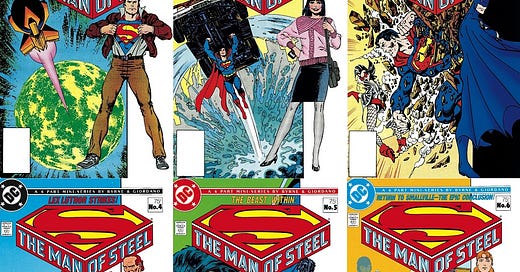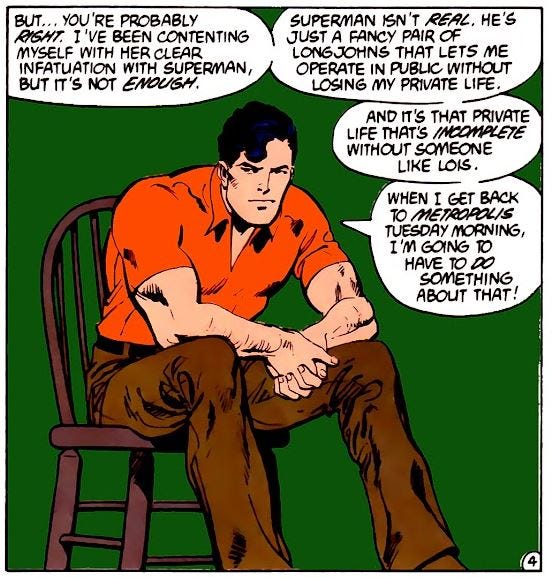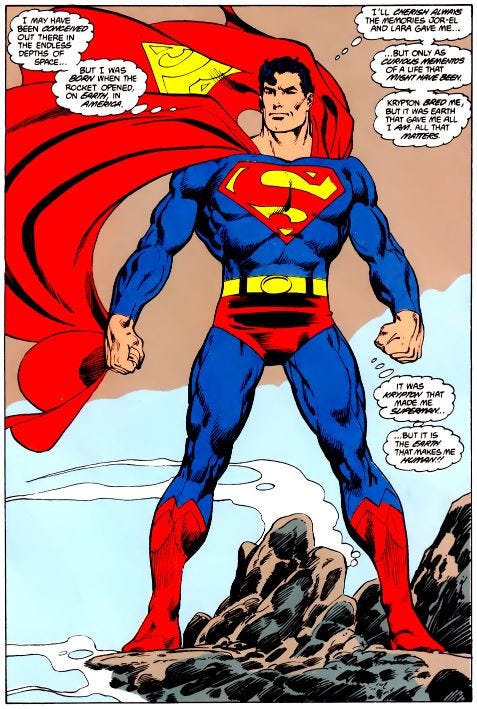The Man of Steel was a six-issue limited series published July-September 1986, written and penciled by John Byrne and inked by Dick Giordano. The series presented the new origin story for Superman following 1985-1986’s Crisis on Infinite Earths, a 12 issue series that rebooted the DC Comics’ universe. The series made a number of significant changes to the Superman mythos –
DC editors wanted to make changes to the character of Superman, including making him the sole survivor of his home planet Krypton, and Byrne's story was written to show these changes and to present Superman's origin. The series includes the embryonic Kal-El rocketing away from the destruction of Krypton and his birth upon landing in Kansas when he emerged from the artificial womb, Clark Kent as a teenager in Smallville learning that he was found in a crashed space ship, him being hired at the Daily Planet in Metropolis, the creation of his secret identity of Superman, his first meeting with fellow hero Batman, and how he finally learned of his birth parents and from where he came. The series also included the reintroduction of a number of supporting characters, including fellow reporter and love interest Lois Lane and archenemy Lex Luthor, who was re-branded from a mad scientist to a powerful businessman and a white-collar criminal.
I first read The Man of Steel sometime around ‘89-90 when I was a teenager. I read it again in 2020 when Superman: The Man of Steel Omnibus, Vol. 1 was released. Both times I enjoyed it. This time, not so much. I think a lot of my dislike this time around was caused by the writing. The writing wasn’t bad, just a product of its time. Some aspects of the story haven’t aged well,
but nothing was egregiously bad or off putting. Mostly it was annoying. Case in point, constantly throughout all six issues, Clark refers to himself in the third person. What, does he think he’s Elmo or something? The dialog and inner-monologues are also stilted in the very comics-from-the-mid-80s kind of way.
What makes The Man of Steel important and thus one of the Great Superman Stories is the new status quo that it created for the character. Of those changes, the one that I think is the most significant and consequential was the establishment of Clark Kent as the person and Superman as the disguise. This sentiment is best described in a panel on page 4 of issue # 6 –
That one change drastically humanized Superman.
Ultimately, there have been better retellings of Superman’s origin but they all owe a debt to what John Byrne and the editors at DC did in The Man of Steel.
References
Byrne, J., & Wolfman, M. (2020). Superman: The Man of Steel, Vol. 1. DC Comics.
Greenfield, D. (2023, July 6). Why JOHN BYRNE’S SUPERMAN Was the Greatest Man of Steel Ever. 13th Dimension. https://13thdimension.com/why-john-byrnes-superman-was-the-greatest-man-of-steel-ever/
Lapin-Bertone, J. (2023, May 5). John Byrne’s The Man of Steel is a Perfect Superman Season One. DC. https://www.dc.com/blog/2023/05/05/john-byrne-s-the-man-of-steel-is-a-perfect-superman-season-one
The Man of Steel (comics). (2025, May 18). In Wikipedia. https://en.wikipedia.org/w/index.php?title=The_Man_of_Steel_(comics)&oldid=1290982656
The Man of Steel (1986—1986). (n.d.). DC Database. Retrieved May 25, 2025,from https://dc.fandom.com/wiki/The_Man_of_Steel_Vol_1






